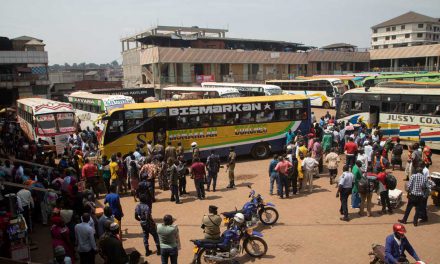
Dakar, Senegal. Photo: Jeff Attaway
Due to the economic relevance and growing concentration of voters in African cities, these territorial entities represent sites of intense political competition
Urbanisation represents one of the main demographic transformations confronting sub-Saharan Africa today, with attendant implications for the region’s long-term development trajectory. Although debate exists over whether Africa can be accurately classified as the fastest urbanising region of the world, it is undoubtedly true that many more Africans now live in urban areas than at any other point in history.
The World Bank predicts that by 2030 Africa will finally be an urban continent, with more than 50% of its population living in cities. Even by 2020, cities such as Dar es Salaam, Kinshasa, Lagos and Nairobi are expected to almost double in size from their 2005 levels, according to a 2010 UN-Habitat study. Increasingly, much of this urbanisation is fuelled more by natural population growth in cities or urban-to-urban, rather than rural-to-urban, migration. While rural-to-urban migration accounted for over 40% of urban growth in the 1960s and 1970s, it accounted for only about 25% during the 1980s and 1990s, according to a 2001 article by Cecilia Tacoli.
While African cities are vibrant locales that generate approximately 60% of the region’s economic growth, according to a 2004 study by Timothy D Sisk, this increase in demographic pressure places a strain on already weak service-delivery mechanisms. Garbage collection, the availability of potable water and sanitation, affordable and predictable electricity, as well as efficient public transport all remain in short supply. Safe and durable housing is particularly lacking, especially in urban centres located in low-elevation coastal zones that are vulnerable to flooding. The result is that, according to UN-Habitat, sub-Saharan Africa has among the world’s highest rate of urban dwellers living in slums.
Without creating sufficient job opportunities in labour-intensive industries, 61% of urban employment is concentrated in the low-income and unstable informal sector, according to a 2006 study by Christine Kessides. In turn, this means that few urban residents constitute a viable tax base for funding the provision of key public services. Consequently, many urban agglomerations have become what AbdouMaliq Simone terms “pirate cities”, in which people must rely on pirate operators, such as mobile water vendors or illegal electricity connections, in the absence of genuine state engagement.
Improving service delivery in African cities is not simply a technical exercise. Rather, it requires consideration of two inter-related dynamics relevant to governance contexts at both local and national levels.
First, as a consequence of decentralisation, the responsibility for the provision of key services has theoretically been transferred to sub-national authorities in a number of African countries. The design and implementation of decentralisation policies has often been erratic, however, with complex layers of government resulting in overlapping mandates and high levels of poverty depriving local governments of adequate resources. Although much has been written on decentralisation in Africa, there has rarely been an exclusive focus on cities in particular.
Secondly, the underlying challenges of decentralisation are magnified by democratic politics in Africa’s current multi-party era. Political decentralisation, in particular, has resulted in a number of countries facing a situation of “vertically divided authority”, whereby an opposition party has been elected to manage a major urban agglomeration, such as a capital city. This trend has been observed at various times over the past decade in African cities as diverse as Cape Town, Cotonou, Dakar, Gaborone, Kampala, Lagos, Lusaka, and Nairobi.
As noted below, vertically divided authority can augment the trade-offs between autonomy and accountability that are inherent in the decentralisation process, leading to possible “strategies of subversion” by national governments that are loath to see political opponents win credit for good performance but eager to assign blame when services are poorly delivered. Historically in Africa, cities are where opposition parties first gain a foothold on their countries’ political scene before potentially garnering national support.
Due to the economic relevance and growing concentration of voters in African cities, these territorial entities therefore represent sites of intense political competition. As Mamadou Diouf observed in a 1996 article: “The city is the seat of power, the terrain for expressing the imaginary of the ruling class and its ascendance. In this field, there are no possibilities other than confrontation and negotiation.”
Given the subversive strategies that have been adopted by national governments to undermine urban authorities, we need to consider mechanisms that could mitigate the negative impacts of vertically divided authority.
These two governance concerns present important implications for the international donor community. Because of low resource bases, many municipalities rely on donor financing to fund their service-delivery needs, even though donors’ support and modes of engaging with the urban sector have changed dramatically over the past few decades. In a number of African countries, however, only the central government can directly negotiate with donors. This places donors, which are often self-proclaimed apolitical entities, in a very difficult position in situations of vertically divided authority.
There are various forms of decentralisation, including deconcentration, delegation and devolution. While deconcentration involves the central government re-distributing some decision-making authority from the central to the field offices of national ministries, delegation entails the transfer of responsibility for certain public functions to sub-national governments. By contrast, devolution requires not only transferring responsibility but also authority over decision making and accountability to autonomous and legally constituted sub-national governments.
Decentralisation also involves political, administrative, and fiscal elements. The administrative element refers to the transfer of responsibilities for the delivery of certain services to sub-national governments, while fiscal decentralisation requires that local governments possess a high level of discretion over the formulation and allocation of budgets. Political decentralisation refers to the regular election of local leaders through secret and free and fair ballots. For our purposes, decentralisation is equated with devolution, precisely because devolution cannot exist in the absence of political decentralisation.
For two decades, decentralisation has been at least rhetorically embraced as a priority for Africa’s development agenda. An analysis of all the current Poverty Reduction Strategy Papers (PRSPs) for Africa reveals that 25 countries list decentralisation as a key objective, typically categorised as part of their strategy for achieving “good governance”. Improved governance has long constituted one of the two main justifications for decentralisation. Specifically, by bringing decisions closer to the people, decentralisation might empower local citizens and increase both upward and downward accountability between elected decision makers and local citizens.
Improved service delivery represents a second justification for decentralisation. In this perspective, decentralisation can facilitate the ability of local governments to tailor services to local preferences and needs as well as encouraging competition among local governments to retain residents by providing the most efficient services. In reality, the ability of decentralisation to achieve both goals has been questioned, based on both theoretical and empirical grounds.
In the African context, much of the impetus for decentralisation has been primarily political, and the election of sub-national authorities has been sequenced before other elements of the decentralisation process. In South Africa, decentralisation was a way of maintaining stability at the time of negotiated transition away from apartheid in 1994. The apartheid-era National Party demanded that the ANC adopt a policy to promote strong provinces with guaranteed access to revenues to ensure that white Afrikaners would not be excluded from the political sphere, according to a 2011 study by J Tyler Dickovick.
As Gina Lambright showed in a 2014 article in a special edition of the Development Policy Review, of which an earlier version of this article was a part, decentralisation in Uganda was essentially a compromise position by President Yoweri Museveni, who refused to allow multi-party competition at the national level until a referendum in 2005 required it. Local participatory democracy corresponded well with the grassroots resistance councils that Museveni’s National Resistance Movement (NRM) set up in the 1980s. In Senegal, meanwhile, the Parti Socialiste (PS) initiated decentralisation reforms in 1996 as a means of retaining party support at the local level, particularly in rural areas, even though it was losing credibility at the national level.
In all the three countries mentioned, various forms of political decentralisation had existed at the municipal level. But a country’s electoral rules can have important implications for the nature and degree of accountability that electoral officials have to their constituents. For example, in Cape Town, the councillors are nominated by party bosses rather than directly selected by voters. In Dakar, a constituency-based system is used, but candidates are required to be affiliated with an existing political party and cannot run as independents. By contrast, given Uganda’s “no party” system, candidates for municipal office historically had to run as independents with no party affiliation.
Fiscally, the cities in each of these countries are more economically viable than the rural areas, but they demonstrate important variations. South Africa is one of Africa’s most developed economies, and its cities have a larger tax revenue base on which to draw, particularly Cape Town. In fact, as Robert Cameron shows in an article in the special edition of Development Policy Review mentioned earlier, only about 15% of Cape Town’s budget comes from government grants. Moreover, such government funding that the city does receive is based on constitutional stipulations that provide local government with an equitable share of nationally raised revenue.
Meanwhile, only 20% of Dakar’s revenue comes from the country’s two main types of inter-governmental resources, the Fonds de dotation de la décentralisation (FDD) and the Fonds d’équipement des collectivités locales (FECL). However, as I showed in another article in the special edition of Development Policy Review mentioned above, the distribution of these resources, particularly the FDD, is done on an ad-hoc basis, decided annually by a committee of officials that includes the president and the prime minister.
Kampala depends more heavily on central government transfers, which comprise about 47% of its revenues. Lambright argues that Kampala, like other city councils in Uganda, should receive an unconditional grant from the central government based on a formula that takes into account its population and size.
Aside from Cape Town, the level of total revenue in each of these cities is insufficient to address all their needs, which often means that city councils have unfunded mandates. In turn, this can have important implications for service delivery. Cape Town is South Africa’s best-managed city, even more so than Johannesburg. By contrast, Kampala is considered a “modern executive slum” whose performance in areas such as garbage collection lies well below the national average. In Dakar, resources are sufficient to address only three out of nine mandated responsibilities, including health, education, youth and sports. Sectors that have not been decentralised, in particular water and sanitation, perform much better.
The disparate manifestations of the decentralisation process noted above show that vertically divided authority could become problematic for service delivery and governance at the municipal level. One challenge is that high levels of administrative complexity can result in overlaps in responsibilities between different layers of government. Also, decentralisation typically alters relationships of accountability between citizens and elected politicians, as well as those between central and sub-national policymakers, according to a 2005 study by Junaid Ahmed et al. Both central and local government actors will prefer a decentralisation process that maximises their autonomy, but they will also prefer to be held accountable only when service delivery outcomes are favourable.
The preference for greater autonomy and more malleable lines of accountability is exacerbated under conditions of vertically divided authority when different political parties are in control at the national and local levels. When the national and sub-national governments are in the hands of the same party we would expect the national government to encourage better service delivery at the local level. In such cases, the divestiture of autonomy is less egregious and there are strong, electoral spillover effects between constituents’ perceptions of local and national leaders.
Exceptions might occur when intra-party divides exist, because they could lead to an active undermining of independent-minded mayors whose individual success at service provision poses a threat to party leaders. This was the case in Mozambique, for example, where the mayor of Beira, Daviz Simango, was considered by his RENAMO party to be “too competent” and therefore threatening to the party’s elite. RENAMO expelled Simango in 2008, but he ran as an independent candidate in the 2008 municipal elections and was re-elected mayor by a landslide vote.
Where elections are concurrent, such an institutional arrangement usually causes voters to view local and national politicians as equally responsible for performance. Under divided authority, the national government obtains little reward for helping sub-national officials from opposition parties. Based on observations from the Latin American context, where vertically divided authority became more pronounced in the 1980s as mayors were increasingly elected, a 2002 study by David Myers noted: “When the capital city mayor and the president belonged to opposing political parties the basic issues that divided their parties complicated relations between them.”
Collectively, then, divided authority can encourage the central government to employ strategies of subversion, or tactics designed to limit the autonomy of sub-national officials while simultaneously increasing their culpability for poor service delivery. To obscure political motivations, these strategies are often justified via the use of a development discourse. In other words, the central government may stress that its interventions are driven by a desire to improve local development.
As noted earlier, political decentralisation involves increasing the voice of local communities by shifting away from national appointments of sub-national authorities and instead allowing such authorities to be elected. Since elections are viewed as the key mechanism for enforcing accountability, political decentralisation offers sub-national officials the ability to be rewarded or punished for performance. Sub-national officials will prefer to be elected rather than appointed to their positions because they can then advocate in favour of those policies most relevant to their communities without fear of removal by the central government.
By contrast, the ruling regime at the national level will be more concerned about manipulating power relations at the local level and, therefore, less favourable to political decentralisation if it involves relinquishing control, especially to sub-national authorities which are from the opposition. For example, the ruling party in Namibia amended its Regional Councils Act in 2010 to allow the president to appoint regional governors in those regions of the country where the ruling party lacked majority representation. According to the ruling-party spokesperson, the change was needed “because the opposition may block some government development projects … so that in the end, they will claim that government failed to deliver.”
Similarly, the ruling Botswana Democratic Party (BDP) has often appointed additional councillors – who enjoyed the same privileges as their elected counterparts – to cities controlled by the opposition Botswana National Front (BNF). The government argued that this enabled districts that had specific development needs to nominate additional councillors who possessed the relevant skills. Similarly, when the opposition gained control of Cameroon’s major urban councils in the municipal elections of 1996, the ruling Cameroon People’s Democratic Movement (CPDM) appointed CPDM delegates who had the power to manage council projects and finances.
According to a 2005 study by Tulia Falleti, central governments are most favourable to administrative decentralisation, because national governments will generally prefer to divest themselves of as many expenditure responsibilities as possible. However, in their 2003 study, Matt Andrews and Larry Schroeder offer an important caveat to this claim. Based on the cases of Tanzania and Zambia, they note that national politicians are least likely to relinquish control over providing those public services that are highly visible to political constituencies and which offer important opportunities for donor funding.
A more nuanced position most probably prevails with regard to vertically divided authority. In such cases, the central government might be willing to relinquish responsibilities to a local government where public services might fail, but take control of them when there is the possibility for electoral gain. For example, the arrival of an opposition mayor, Ricardo Belmont, in Lima, Peru during the mid-1990s became a source of concern for President Alberto Fujimori. He tried to deprive the mayor of any popularity by announcing that he would invest $140 million in education and public works, despite Belmont’s protests that such activities were really the responsibility of local government.
In Mexico, the arrival of democratic elections brought a mayor from the opposition Partido de la Revolución Democrática (PRD), Cuauhtémoc Cárdenas, to power in Mexico City in 1997. The ruling party, the Partido Revolucionario Institucional (PRI), resisted helping Cárdenas to combat drug crime in the city because it feared that successfully tackling this problem would hurt the PRI in subsequent elections, according to a 2002 article by Diane Davis.
These challenges with regard to administrative decentralisation also affect fiscal decentralisation. In general, sub-national officials will prefer inter-governmental transfers to support service delivery because they do not want to lose popularity with their citizens by raising taxes. Such transfers also allow local government to shift blame for poor service delivery to the central government, reducing accountability. National governments, however, prefer that local governments rely on taxes rather than transfers.
Yet divided authority may encourage sub-national authorities to prefer greater taxation powers just because these would reduce their dependence on the central government. Indeed, focusing on the city of Caracas, Steve Ellner and David J Myers observed in 2002 that reliance on resources from the central government hindered each elected mayor’s ability to build a municipal political machine. Alternatively, situations of divided authority where local tax bases are low may encourage sub-national authorities to eschew tax mobilisation in favour of transfers that are not earmarked for specific purposes by the central government and which are delivered on a predictable and regular basis.
Otherwise, such transfers are vulnerable to manipulation by the central government and augment the inability of politically disadvantaged, sub-national governments to deliver services. In Zambia, for example, efforts in 2008 by the then-opposition Patriotic Front (PF) to fight cholera in Lusaka were thwarted by the late delivery of resources from the central government. Of course, there may also be economic reasons why local governments might prefer tax mobilisation to inter-governmental transfers or borrowing. Specifically, they often require an emphasis on maintaining “hard budget constraints” to prevent sub-national governments from spending more than they can afford.
The cases mentioned above all highlight the existence of such strategies of subversion in African contexts. The most extreme example was Uganda, where a parliament dominated by Museveni’s NRM party passed the Kampala City Act in 2009. This Act removed the authority of the city council to govern Kampala, replacing it with a Kampala Capital City Authority (KCCA), which made the role of elected mayor an essentially ceremonial position, while a new executive director, appointed directly by the president, holds executive authority. Although justified on the basis of improving service delivery, the timing of the decision had clear links to partisan struggles. Overall, the move was a major reversal in a country once known as one of Africa’s most decentralised.
Though less extreme, a similar tactic was used under former president Abdoulaye Wade in Senegal, particularly after the BSS coalition gained control of a majority of the country’s urban councils in the 2009 local elections. Wade’s government engaged heavily in the practice of découpage, which involves subdividing administrative units into smaller entities. Elected officials were removed from their posts and replaced by appointed “special delegations” – usually members of Wade’s PDS party. Again, the justification was improved service delivery through bringing government even closer to the people. However, given that predominantly opposition strongholds were targeted, the tactic appeared to have strongly partisan overtones.
Political interference was still present but less extreme in the South African case. Just days before local elections in 2006, for instance, sensing that it would lose Cape Town to the opposition DA, the ANC attempted to renew the contract of the party-appointed city manager. However, this violated legislation requiring the city manager to be installed by the full city council. The ANC had already considered changes to the electoral system that would have seen local elections held at the same time as national ones, which would have created an advantage for the ruling party in Cape Town, because it had typically won a majority of votes in the city in national elections.
South Africa’s constitution includes clearly specified rules regarding mandated transfers, and in such a context fiscal decentralisation would appear to be least susceptible to the challenges of vertically divided authority. Indeed, sub-national governments prefer constitutionally mandated transfers because they are the least susceptible to political machinations by central governments. Some concerns have been raised that Cape Town has received a lower share of unconditional grants as a share of its population than Johannesburg, but this could be because the city’s population has grown substantially since the last national census, on which the allocations are based. The city’s high tax base has nevertheless mitigated the potential impact of any reduction in inter-governmental transfers on service delivery.
Uganda provides inter-governmental transfers to local governments based on a formula derived by population and size. Yet Kampala does not receive funds commensurate with its responsibilities and size, and its high dependence on central-government funding creates space for political manipulation. Since many of these transfers are conditional, they also limit the policy options of local government. More recently, Museveni has even eliminated important sources of local revenue for Kampala, including the graduated tax exempting owner-occupied residences from property taxes, and the tax on boda bodas, or motorcycle taxis. These reductions have negative implications for key services such as garbage collection.
The system of inter-governmental transfers in Senegal is probably the most vulnerable to political machinations. There, funding decisions are decided on an annual basis according to a committee presided over by the president. Government transfers to Dakar have declined since the BSS coalition came into office, despite the city’s large population and growing service needs. Often, the transfers are released too late in the year to be properly included in the budgets of the local municipalities.
In the administrative domain, the cases suggest that central governments do try either to rescind responsibilities for highly visible services that could bolster the popularity of the opposition or to offload important tasks to local government that could undermine the latter’s reputation. In Senegal, Wade’s government launched a series of high profile, but relatively unsuccessful, projects to support victims of urban flooding in Dakar during most of the president’s tenure in office. However, the responsibility for this matter was then offloaded to local government after a coalition, United to Boost Senegal (Wolof: Bennoo Siggil Senegaal, and known as BSS), came to office in 2009. This occurred despite the fact that local government tends to lack the capacity to handle such a perennial development challenge, which is a major source of discontent for poor Dakarois.
At the same time, Wade’s government removed the city’s responsibility for garbage collection soon after local-government officials devised a new strategy for a more effective mode of solid-waste disposal. In Kampala, the central government constructed a sewage plant in one of the city’s wetlands, which directly undermined the city council’s responsibility for preventing illegal construction in the area. This opened the door for thousands of residents to construct illegal homes there, undermining the city’s authority.
As a 2005 study by Nick Devas showed in the Indian context, rescinding local-government responsibilities is problematic precisely because it erodes the degree of accountability between local citizens and elected municipal officials – “removing key functions from local-level decision making risks weakening whatever influence the urban poor have on the services that affect them”.
The South African case is more nuanced. The ANC did remove Cape Town from participating in the N2 Gateway housing scheme in March 2006, just after the DA was elected. The scheme was a highly visible project aimed at providing disadvantaged populations with proper housing. According to Robert Cameron, who authored the South African case study in the special issue mentioned above, one motivation for this move was that the ANC feared that the opposition would uncover evidence of patronage-based allocations of housing to the ruling party’s supporters. Yet, compared with the other cases, examples of interference at the administrative level have been less apparent in South Africa.
There are a number of reasons why such patterns emerge. First, the degree of administrative ambiguity that already exists across different levels of government creates the opportunity to shift responsibilities for certain services. The more vague the laws related to administrative decentralisation are, the more likely that there is space for political manipulation.
Secondly, in certain countries, important incentives that mitigate excessive political interference in local service delivery might be developed. For instance, South Africa’s national ministers have performance contracts with the president in the area of service delivery. Since Cape Town has a good reputation for capacity and delivering services, even ANC ministers often support the efforts of the city because this could, in turn, improve the ministers’ own image.
As Africa’s rapid urbanisation continues apace and as its nascent democracies become more consolidated, the intersection between governance and service delivery will undoubtedly become more pronounced. The challenge will be to determine whether isolated attempts at recentralisation are truly motivated by concerns over poor service delivery and low capacity at the municipal level or by political considerations by central governments.
A version of this article was published in Development Policy Review, 2014, 32. This version is published under a Creative Commons licence, with some editing as approved by the author.
Danielle Resnick is a senior research fellow in IFPRI’s Development Strategies and Governance Division (DSGD). A political scientist, her research interests include the impacts of public sector reforms on accountability and efficiency, drivers of agricultural policy volatility and reform, urban governance structures and their influence on service delivery, democratization and political participation, and foreign aid effectiveness. An author and co-editor of several academic studies, she has conducted fieldwork in Botswana, Burkina Faso, Ghana, Malawi, Nepal, Senegal, and Zambia. She received her PhD in Government from Cornell University in 2010.














